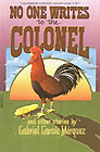More Books by García Márquez

PAGE 3
No One Writes to the Colonel and Other Stories (1961)
By Gabriel García Márquez
Having moved out from the shadow of Faulkner—he jokingly claims he did this "by reading Hemingway"—García Márquez creates an absolute jewel of a novella in No One Writes to the Colonel, a story that evokes the entire range of human emotions from misplaced hope to blackest cynicism. The town in which it is located is not Macondo, although Macondo exists downriver; the locale is an unnamed port town where the mail comes in by ship every Friday. Scattered throughout the town are several unforgettable characters: the cynical Doctor; the wry, wealthy, and diabetic Sabas; Father Angel, who forbids the citizens from seeing morally questionable movies by ringing the church bell twelve times; the Colonel's frustrated wife; and most importantly, the Colonel himself. A different Colonel than the central figure in Leaf Storm, he is obviously based on the same archetype—ostensibly García Márquez's grandfather. The Colonel is a stately, honorable man, but perhaps a bit idealistic. For fifteen years every Friday, he has been faithfully anticipating the arrival of the pension check promised by a long overthrown government. Near poverty, half-starved, and living on credit, he and his wife have just lost their son, who was shot to death by the opposing political party. His only legacy is a prize rooster, an excellent fighting cock and a sure-fire winner in next January's match. But to keep this potential breadwinner alive until then, he must be fed—and the more food that goes to the rooster, the less for the Colonel and his wife. The Colonel's predicament unwinds as the narrative takes him through the town and it's cast of characters, all of which have their own unique perspective on the vicissitudes of the world.
By Gabriel García Márquez
Having moved out from the shadow of Faulkner—he jokingly claims he did this "by reading Hemingway"—García Márquez creates an absolute jewel of a novella in No One Writes to the Colonel, a story that evokes the entire range of human emotions from misplaced hope to blackest cynicism. The town in which it is located is not Macondo, although Macondo exists downriver; the locale is an unnamed port town where the mail comes in by ship every Friday. Scattered throughout the town are several unforgettable characters: the cynical Doctor; the wry, wealthy, and diabetic Sabas; Father Angel, who forbids the citizens from seeing morally questionable movies by ringing the church bell twelve times; the Colonel's frustrated wife; and most importantly, the Colonel himself. A different Colonel than the central figure in Leaf Storm, he is obviously based on the same archetype—ostensibly García Márquez's grandfather. The Colonel is a stately, honorable man, but perhaps a bit idealistic. For fifteen years every Friday, he has been faithfully anticipating the arrival of the pension check promised by a long overthrown government. Near poverty, half-starved, and living on credit, he and his wife have just lost their son, who was shot to death by the opposing political party. His only legacy is a prize rooster, an excellent fighting cock and a sure-fire winner in next January's match. But to keep this potential breadwinner alive until then, he must be fed—and the more food that goes to the rooster, the less for the Colonel and his wife. The Colonel's predicament unwinds as the narrative takes him through the town and it's cast of characters, all of which have their own unique perspective on the vicissitudes of the world.



